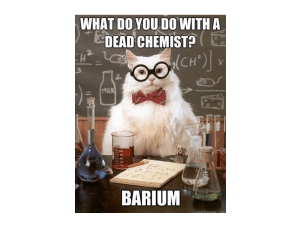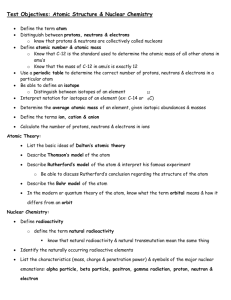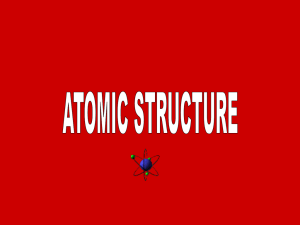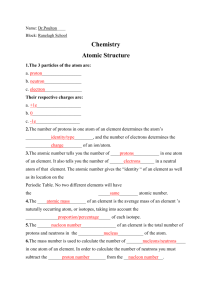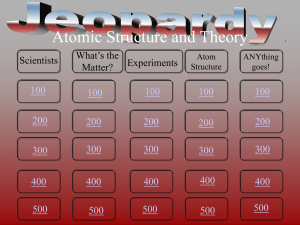SBI 4U CHEMISTRY REVIEW
advertisement
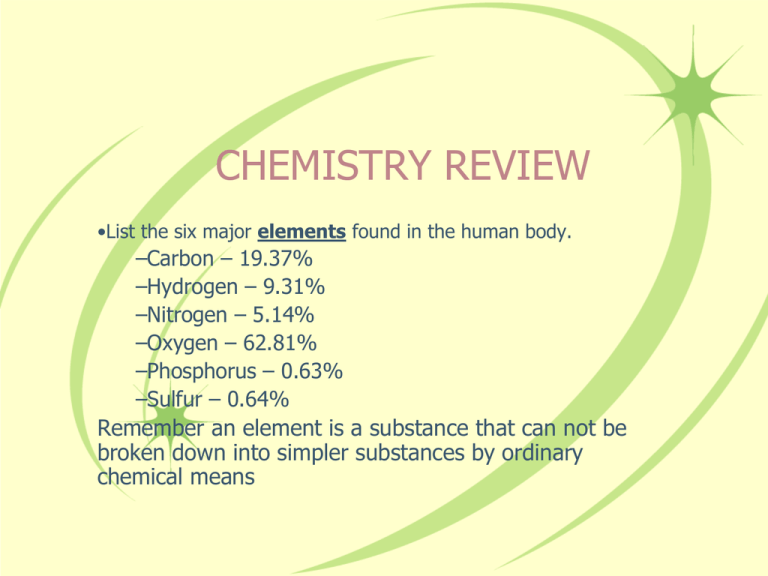
CHEMISTRY REVIEW •List the six major elements found in the human body. –Carbon – 19.37% –Hydrogen – 9.31% –Nitrogen – 5.14% –Oxygen – 62.81% –Phosphorus – 0.63% –Sulfur – 0.64% Remember an element is a substance that can not be broken down into simpler substances by ordinary chemical means The smallest part of an element that retains the elements properties is an atom. Standard atomic notation M = mass number (protons + neutrons) E = element A = atomic number [number of protons (p+) in an atom] Determines the identity of an atom! NOTE: Mass number – atomic number = number of neutrons (n0) Atomic Structure Orbitals/shells contain electrons (e-) which determine the chemical reactivity of an element! Nucleus contains protons and neutrons (p+) (n0) Try this… http://www.kscience.co.uk/animations/atom.htm Ions: changing the number of electrons in an atom (mass and atomic number remain unchanged) • An atom that carries an electrical charge is called an ion • If the atom loses electrons, the atom becomes positively charged (because the number of positively charged protons will be more than the number of electrons) This positively charged ion is called a cation. Ions continued • If an atom gains electrons, the atom becomes negatively charged (more negative charges than positive charges) This is called an anion Ions in biological systems • H+ (hydrogen ions) are critical to the process of cellular respiration. • Na+ are part of transport mechanisms that enable other molecules to enter cells • Na+ and K+ are critical to nerve impulses • Ca2+ is critical to neurotransmitter release or muscle functioning. Isotopes • Atoms with the same atomic number (p+) but different atomic masses. • Thus they contain a different number of neutrons but the same number of protons and electrons. (p+) (e-) (no) 12 6C 6 p+ 6e- 6n0 Carbon - 12 13 6C 6 p+ 6 e- 7 n0 Carbon - 13 14 6C 6 p+ 6 e- 8 n0 Carbon – 14 Unstable & radioactive Isotopes Half-life • Time it takes for half of the radioactive nuclei to decay in a radioisotope. Useful Applications of Radioisotopes 1. RADIOMETRIC DATING: radioactive isotopes decay at a predictable rate – Living organisms have the same amount of C-12 and C-14 as in the atmosphere. – When an organism dies C-14 starts decaying to C-12 at a constant rate. – Scientists measure the ratio of C-12:C-14 in dead fossilized organisms to predict time of death. Carbon dating Useful Applications Radioisotopes continued 2. Radioactive Tracers: Radioisotopes are used to follow chemicals through chemical reactions and trace their path as they move through cells/bodies of living organisms. This has applications in biological, chemical, and medical research. Example 1: Thyroid Gland • The thyroid gland uses iodine to make hormones that influence growth and metabolism. – Doctors administer radioactive iodine-131, and then use a photographic device to trace the radiation Example 2: Using positron emission tomography (PET) to diagnose cancer tumours • Cancerous tissues are characterized by a much higher level of activity than healthy tissues. • Thus cancer cells take in more glucose – a common cellular energy source – than healthy cells. • If a patient is injected with radioactive glucose and then a PET scan can be done to determine the location of a cancerous tumour. Questions to consider 1. What radionuclide tends to be used for PET scans in place of glucose? 2. What happens to glucose when it is taken up by a cell? What happens to the modified molecule that is taken up by the cells? 3. What is a positron? 4. What other imaging techniques are often used with PET scans? 5. What is the generalized half life of the radionuclides used in PET scans? Explain. Assignment • Answer questions #16 on page 10 of your textbook.


